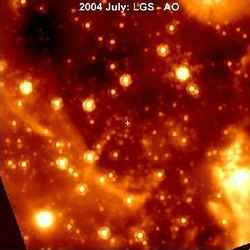
The center of our Milky Way galaxy captured by Keck Laser Guide Star. Image credit: W.M. Keck Observatory/UCLA Click to enlarge
UCLA astronomers and colleagues have taken the first clear picture of the center of our Milky Way galaxy, including the area surrounding the supermassive black hole, using a new laser virtual star at the W.M. Keck observatory in Hawaii.
“Everything is much clearer now,” said Andrea Ghez, UCLA professor of physics and astronomy, who headed the research team. “We used a laser to improve the telescope’s vision ? a spectacular breakthrough that will help us understand the black hole’s environment and physics. It’s like getting Lasik surgery for the eyes, and will revolutionize what we can do in astronomy.”
Astronomers are used to working with images that are blurred by the Earth’s atmosphere. However, a laser virtual star, launched from the Keck telescope, can be used to correct the atmosphere’s distortions and clear up the picture. This new technology, called Laser Guide Star adaptive optics, will lead to important advances for the study of planets in our solar system and outside of our solar system, as well as galaxies, black holes, and how the universe formed and evolved, Ghez said.
“We have worked for years on techniques for ‘beating the distortions in the atmosphere’ and producing high-resolution images,” she said. “We are pleased to report the first Laser Guide Star adaptive optics observations of the center of our galaxy.”
Ghez and her colleagues took “snapshots” of the center of the galaxy, targeting the supermassive black hole 26,000 light years away, at different wavelengths. This approach allowed them to study the infrared light emanating from very hot material just outside the black hole’s “event horizon,” about to be pulled through.
“We are learning the conditions of the infalling material and whether this plays a role in the growth of the supermassive black hole,” Ghez said. “The infrared light varies dramatically from week to week, day to day and even within a single hour.”
The research, federally funded by the National Science Foundation, will be published Dec. 20 in the Astrophysical Journal Letters.
The research was conducted using the 10-meter Keck II Telescope, which is the world’s first 10-meter telescope with a laser on it. Laser Guide Star allows astronomers to “generate an artificial bright star” exactly where they want it, which reveals the atmosphere’s distortions.
Since 1995, Ghez has been using the W.M. Keck Observatory to study the galactic center and the movement of 200 nearby stars.
Black holes are collapsed stars so dense that nothing can escape their gravitational pull, not even light. Black holes cannot be seen directly, but their influence on nearby stars is visible, and provides a signature, Ghez said. The supermassive black hole, with a mass more than 3 million times that of our sun, is in the constellation of Sagittarius. The galactic center is located due south in the summer sky.
The black hole came into existence billions of years ago, perhaps as very massive stars collapsed at the end of their life cycles and coalesced into a single, supermassive object, Ghez said.
Co-authors on the research include UCLA graduate students Seth Hornstein and Jessica Lu; the adaptive optics team at W. M. Keck Observatory: David Le Mignant, Marcos Van Dam and Peter Wizinowich; Antonin Bouchez (formerly with the W. M. Keck Observatory) and Keith Matthews at Caltech; Mark Morris, a UCLA professor of physics and astronomy; and Eric Becklin, a UCLA professor of physics and astronomy.
Ghez provides more information, and images of the galactic center, at http://www.astro.ucla.edu/research/galcenter/.
Original Source: UCLA News Release

i like study